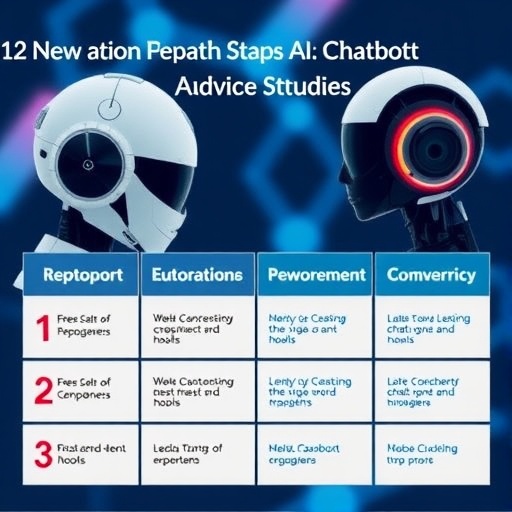In recent years, artificial intelligence (AI) chatbots have emerged as transformative tools in delivering health advice, revolutionizing how patients access medical information and support. However, the rapid proliferation of these AI-driven conversational agents has presented a pressing need for standardized reporting practices. Recognizing this critical gap, a team of international researchers spearheaded the development of the Chatbot Assessment Reporting Tool (CHART), a comprehensive guideline designed to enhance the transparency, reproducibility, and interpretability of AI chatbot health advice studies used for clinical purposes.
The genesis of CHART stems from an inherent challenge within the current landscape of AI-enabled health technologies: the inconsistency in reporting study methodologies and outcomes. Without a unifying framework, clinicians, researchers, and policy makers face difficulties in adequately evaluating the validity, safety, and applicability of chatbot-based interventions. To address this, the CHART initiative undertook a rigorous, multi-phase development process aimed at distilling consensus around essential reporting components that accurately capture the complexity of AI chatbot evaluations.
Central to the CHART development was a systematic literature review that meticulously mapped the scope of existing reporting standards in AI and digital health studies. This review identified notable deficiencies in capturing chatbot-specific nuances such as conversational design, interaction context, and the AI model’s decision-making transparency. Building on these insights, the project convened a Delphi consensus exercise with over 500 stakeholders representing diverse international perspectives from clinical, technical, regulatory, and patient advocacy spheres.
The Delphi process, characterized by iterative anonymous surveys, engaged 531 experts across multiple rounds to refine and prioritize the critical elements that should be reported in chatbot health advice studies. This robust consensus-building method allowed for transparent, unbiased convergence of expert opinion, ultimately culminating in the identification of a 12-item checklist capturing the multifaceted dimensions unique to AI chatbot research. These checklist items encompass areas including chatbot development, validation procedures, ethical considerations, user interaction data, and clinical outcomes evaluation.
Complementing the checklist, CHART features a methodological diagram designed to visually articulate the flow of chatbot study design and reporting. This diagram serves as a navigational tool to guide researchers through sequential phases such as algorithm training, user interface deployment, data collection, and outcome assessment. By providing a clear visual framework, CHART facilitates consistent and comprehensive representation of complex study architectures, which is especially vital for peer reviewers and journal editors evaluating manuscript submissions.
The introduction of CHART carries significant implications for stakeholders throughout the healthcare ecosystem. For clinicians, it offers a reliable basis to interpret the scope and limitations of chatbot interventions before integration into clinical workflows. Researchers benefit by aligning their reporting with a globally endorsed standard, enhancing the rigor and comparability of future studies. Health system administrators and policy makers gain trustworthy evidence to inform decisions on adopting and regulating AI-driven health tools.
Moreover, CHART addresses pivotal ethical and safety concerns intrinsically linked to AI chatbots providing health advice. Transparent reporting of model development, validation, and potential biases empowers stakeholders to assess risks and safeguard patient well-being. This transparency is increasingly critical as chatbots evolve beyond basic symptom screening to more complex tasks such as mental health counseling and chronic disease management.
The CHART guideline also plays a foundational role in advancing interdisciplinary collaboration by harmonizing terminology and reporting expectations among computer scientists, clinicians, and health services researchers. As AI chatbot technologies continue to intersect with areas such as natural language processing, machine learning interpretability, and human-computer interaction, a shared reporting language is essential to foster innovation while maintaining scientific rigor.
Encouragingly, early adoption of CHART by journal editorial teams signals a commitment to elevating research quality and reproducibility in this nascent field. By incorporating the CHART checklist into peer review workflows, journals can ensure that published chatbot health advice studies meet high methodological and reporting standards, ultimately accelerating trust and dissemination of effective AI tools.
The development of CHART represents a landmark step toward systematic evaluation and transparency in AI chatbot research focused on health advice. As AI chatbots become increasingly integrated into patient care and public health initiatives, the existence of clear, consensus-driven reporting guidelines will be crucial in navigating their safe and effective deployment. Stakeholders worldwide are now equipped with a meticulously crafted tool to interpret, communicate, and build upon chatbot health advice studies with confidence.
This initiative exemplifies how collaborative, multi-disciplinary approaches can address complex challenges inherent in emerging AI technologies in healthcare. By prioritizing robust reporting standards and stakeholder engagement, CHART sets a precedent for future efforts aimed at fostering responsible innovation in digital health. The scalability and adaptability of the CHART framework may prove instrumental as AI’s role in medicine continues to expand, ensuring patient-centric, evidence-based utilization of conversational agents.
In conclusion, the advent of the Chatbot Assessment Reporting Tool heralds a new era of accountability and clarity in AI chatbot health research. By mandating comprehensive disclosure of study design, implementation, and outcome metrics, CHART not only facilitates rigorous scientific evaluation but also cultivates public trust in these digital health interventions. As the healthcare community navigates the AI frontier, tools like CHART will be indispensable in guiding ethical, effective, and transparent integration of technology into patient care.
Subject of Research: Reporting standards and evaluation methodology for AI chatbot health advice studies
Article Title: Reporting Guideline for Chatbot Health Advice Studies: Chatbot Assessment Reporting Tool (CHART) Statement
Web References: https://www.annfammed.org/content/23/5/389
Keywords: Family medicine, AI common sense knowledge, Generative AI, Health care




